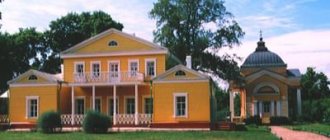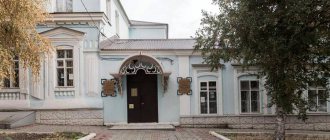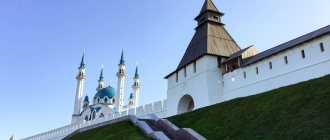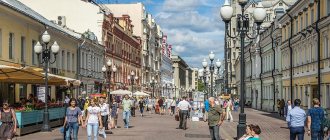Updated: 06/09/2021 21:32:07
Expert: Elizaveta Aleksandrovna Davydova
*Review of the best according to the editors of expertology.ru. About the selection criteria. This material is subjective in nature, does not constitute advertising and does not serve as a purchase guide. Before purchasing, consultation with a specialist is required.
The small island town of Sviyazhsk is an unusual and picturesque place that attracts tourists with many historical and religious attractions, as well as beautiful views. This village, located in the Zelenodolsk region of Tatarstan on an island, is one of the most important places on the territory of the entire subject of the Russian Federation. Many interesting historical sites have been preserved here, including the oldest monasteries and churches that are over 500 years old. Our experts have compiled a rating of the 25 best attractions of Sviyazhsk.
Story
Ivan the Terrible himself decided to build a fortified city after a series of failed operations to capture Kazan. It was necessary to create a stronghold to support the army. The island was washed on three sides by the waters of the Shchuka, Sviyaga and Volga rivers, from the elevated area - Round Mountain - distant approaches were visible, and most importantly, the island was located at a distance of a day's march from the capital of the Kazan Khanate.
The fortress was built unnoticed by the enemy. First, fortifications were built near Uglich. After that, they were dismantled and, with the onset of spring, the logs were floated along the Volga to the island, then dragged to the foot of the Round Mountain. It took one month to reassemble the fortress. The construction was led by the famous Russian architect of that time, Ivan Vyrodkov.
The city consisted of eighteen towers, residential buildings and an Orthodox church. The fortress fully fulfilled its purpose: a year after its foundation, Kazan was taken.
The origins of the city-city of Sviyazhsk
The history of the creation of the city is connected with the development of this region by the Russians, or more precisely with the conquest and annexation of the Kazan Khanate to the Russian state.
In the 15th century, in this place there stood a cone-shaped hill overgrown with centuries-old forest - Mount Kruglaya, surrounded by the rivers Shchuka and Sviyaga. And already in the middle of the 16th century there was a powerful fortress of the Russian Tsar Ivan the Terrible
, which grew up on enemy soil like a fairy-tale city, at the behest of a pike...
Beginning in 1547, Ivan the Terrible undertook systematic campaigns against Kazan
, but they were all unsuccessful. It was clear that without creating a strong support base near Kazan, it was impossible to capture the city. Returning from another unsuccessful campaign in 1550, the young Tsar Ivan drew attention to the ideal military-strategic location of Mount Kruglaya and decided to build a Russian fortress here. But how can it be built unnoticed by the enemy, who is only 30 km away? An ingenious plan was developed: to cut down a city on “Russian soil” in the upper reaches of the Volga and then lower the marked logs along the water and assemble them on the spot, saving time and effort.
As they say, no sooner said than done. During the winter of 1550-51, walls, towers, huts and even churches were cut down in the Uglek forests. And in the spring, after the opening of the rivers, logs for the future fortress began to be rafted along the Volga and further along Sviyaga. To distract the Kazan residents, Russian troops captured all crossings on the main rivers, and detachments under the command of Prince Serebryany
attacked the residents of Kazan Posad.
The construction of the fortress city of Sviyazhsk was unprecedented at that time - a gigantic amount of work was carried out in one month: the territory was laid out, the forest was cut down, ditches were dug, log buildings were assembled, and the fortress walls were covered with earth and stone. A first-class Russian fortress with eighteen towers, seven of which were travel towers, numerous buildings for housing military forces, as well as the Trinity Cathedral
and
the Church of the Nativity
. The tallest tower was Rozhdestvenskaya with the main entrance gate and a lifting lattice. It housed a guardhouse and an archery with two prisons. The ringing of a large self-breaking clock with a bell announced the changing of the guard.
During the construction of the fortress, the local population was attracted to the side of the Russians: Chuvash, Mari, Mordovians, which provided a reliable rear. Ivan the Terrible named the fortress city Sviyazhsk.
Very soon the new city became not only a military fortress, but also a trade and administrative center in which artisans and traders willingly settled. Already at the beginning of 1552 it was a rich and lively city, with numerous merchants selling livestock and a variety of goods. And 15 years later, Sviyazhsk was already a real city with a fortress (kremlin), posad (prison) and settlements. In the fortress there was the Sovereign's courtyard with artillery and food warehouses
, 2 monasteries, 6 churches, a clerk's hut, etc. Here lived: princes, boyars, military men, clergy, artisans and merchants. There were 6 streets throughout the city, there were 370 houses and 4 shops. The fort had 736 residential buildings, a market with a living room, customs officers, a brewery and a bakery. Residents of settlements were mainly engaged in agriculture.
Capture of Kazan by Ivan the Terrible
It should be noted that the city was not built spontaneously, but according to a specific plan. The main street from Rozhdestvenskie to Nikolomozhaiskie gates divided the city into two halves, and the streets coming from all other entrances to the city merged into it. The central square was located on both sides of the Rozhdestvensky central entrance. On the side of the fortress there were artillery and granary courtyards. The side facing the landing consisted of a guest courtyard and shopping arcades that went down to the pier on the Sviyaga River.
History of the name
Initially, the settlement was called “Novograd Sviyazhsky”. The name of the town comes from the Sviyaga River. Over time, the original name was shortened.
The city's coat of arms was approved only at the end of the 18th century. It is a shield depicting a city sailing on a ship with fish underneath. This emblem fully reflects the amazing history of the construction of the town.
After the conquest of the capital of the Kazan Khanate, the town lost its military significance. Soon the island became a quiet monastic place. With the advent of Soviet power, the history of the town changed dramatically. It was almost completely looted. Over time, prisons and correctional camps were built on the site of temples and monasteries.
Nowadays, the island of Sviyazhsk has been turned into one of the key attractions of the Republic of Tatarstan. Travelers are greeted by white stone monasteries and golden domes of temples. The miracle island hospitably welcomes tourists. Sights attract travelers from all over our country.
Church of Constantine and Helena, Sviyazhsk
At the very shore there is the parish Church of Saints Constantine and Helena. It is visible first of all when you approach the island on a boat. The church was built at the end of the 17th century. At first the belfry was a separate building, but over time it was connected to the church, with a refectory built between them. During Soviet times, the church did not work; it opened only in the 90s. 20th century as a space for exhibition events. The church currently hosts baptisms. In the foreground is the building of the girls' gymnasium, built in 1913-14, which still houses the school.
Sviyazhsk is a sparsely populated rural settlement. In 2016, its population was only 259 people.
Attractions
The city has a rich history. On its territory there is a huge number of religious Orthodox buildings. Be sure to visit:
- Assumption Monastery.
It was built in the middle of the 16th century, a few years after the founding of the city. The first abbot of the monastery was canonized. The main relic is the relics of St. Herman. According to legend, at the beginning of the 20th century, in the wake of the propaganda of atheism, the container with the relics was opened, after which a terrible tornado began to rage, which terrified the people present. In the 30s of the 20th century, a correctional colony was created on the island, as well as an NKVD prison.
- St. Nicholas Church.
It is considered one of the most ancient on the territory of the monastery. It was built from cut stone. A short time later, a bell tower was added to the structure. Its height was 43 meters. This is the tallest building in the town. St. Nicholas Church is visited exclusively by monks.
- Assumption Cathedral.
The temple was built in the second half of the mid-16th century. The style of the building is Pskov-Novgorod. The authors of the project were the creators of Moscow's St. Basil's Cathedral - Ivan Barma and Postnik Yakovlev. The temple is a unique architectural monument. The building is a rare example of Russian art of the sixteenth century. The surviving fresco on the wall of the cathedral depicts St. Christopher with a dog's head. At the Moscow Council in 1667, bestial images of saints were banned and destroyed.
- Trinity Church.
It is part of those buildings that were originally transported to the island by water. Today, this is the only building remaining in the village from those times. The interior decoration of the church has changed over the centuries. Only the configuration of the iconostasis remained unchanged. Over the centuries, the temple was constantly completed. Now it is almost completely restored.
- John the Baptist Monastery.
Built at the end of the 16th century. In the middle of the 18th century, the building was seriously damaged due to fires. Therefore, the monastery received the buildings of the Trinity-Sergius Monastery, which at that time had already been abolished. During Soviet times, there were ordinary warehouses inside the cathedral.
- Cathedral of Our Lady of All Sorrows Joy
. The most impressive religious building on the island. It was built at the end of the 19th - beginning of the 20th centuries. The style of the temple is Byzantine. This iconic building has changed little in a hundred years. The only negative is that during the years of Soviet rule the wall painting was completely destroyed. Now work to restore it is in full swing.
- Church of Constantine and Helena.
It is one of the earliest buildings. The religious building was built by order of Ivan the Terrible immediately after the construction of the fortified city. The church was originally built from wood. But later it was converted into a stone structure. The temple is located on a coastal slope. From here you can enjoy fantastically beautiful views of nature.
- Church of St. Sergius of Radonezh.
Originally made of wood. At the beginning of the 17th century, a new church was built from white limestone. The church is undergoing a re-lighting procedure. This fact is indicated in the chronicle. In winter, the sarcophagus with the remains of St. Herman is placed in this church. - State Historical, Architectural and Art Museum-Reserve "Island-city of Sviyazhsk"
. The institution is located on Moskovskaya Street, 6. It is open to visitors from 10 a.m. to 6 p.m. The museum has one day off a week - Monday. This institution regularly hosts exhibitions dedicated to the history of the city and the region, and organizes walking tours around the town. There you can learn more about the history of the city and visit a lot of interesting places. - Secular buildings of the 19th century
. At one time, Sviyazhsk was a classic county town. Most of the buildings of the 19th century were flooded due to the construction of the Kuibyshev reservoir. - Memorial structures.
Near the central city square there is the “
Wall of the Communards
”.
Next to it is a small obelisk. This is the place where the Red Guards were shot in 1918. There is another memorial next to the Assumption Monastery; it is dedicated to the victims of political repression
.
It was erected after the discovery of a large burial, which dates back to the early forties of the 20th century. At that time, the NKVD prison
. A study of the remains of people showed that some of the prisoners were shot, and the other part died of starvation. - "Horse yard".
Located on the territory of the museum complex. It houses various workshops. The museum consists of several buildings, including a working stable, a gift shop, a guest house and a restaurant.
There are also many unpreserved religious buildings in the town. The places where they were located are marked with signs. Most of these churches look like ruins today. The destroyed churches include the following: Sophia and St. Nicholas churches, the Church of the Annunciation of the Blessed Virgin Mary, the Cathedral of the Nativity of the Blessed Virgin Mary, the Annunciation Parish Church, the Gate Church of the Ascension, the Brethren Corps and the Church of St. Herman. Almost all of them were destroyed in the first half of the 20th century by the Bolsheviks.
Architecture of the ancient island-city
Sviyazhsk urban development combines modernity and antiquity. New buildings are adjacent to buildings of the 18th-19th centuries, which gives the city an extraordinary flavor.
River station building
- Address: Sviyaga River embankment.
The journey around Sviyazhsk begins from here - from the river station, the building of which was built in 2011, but its appearance resembles an old Russian tower of the 19th century. This is a small two-story house made of red brick.
Its unusual appearance is given by kokoshnik roofs with thin spiers and a weather vane over the central part of the building.
As for the facade, rectangular windows with triangular canopies and figured masonry add zest to it. There are lawns and clubs around the station, and behind it there is a view of the far bank of the Volga.
Women's gymnasium building
- Address: pl. Rozhdestvenskaya, 3.
The brick building in the Gothic style was erected at the beginning of the 20th century. Its pediment is decorated with lancet windows and stained glass roses - elements most often found in Catholic churches.
The women's gymnasium was a prestigious educational institution for girls from noble families. It was closed after the revolution, and in its place a regular secondary school was established, which still exists today.
Today the building is recognized as an architectural monument and plays a significant role in the appearance of modern Sviyazhsk.
House of merchant Kamenev
- Address: Rozhdestvenskaya Square, 2.
F.T. Kamenev was one of the richest merchants of Sviyazhsk. He owned factories, groceries and shipyards. It was he who owned the two-story estate, built at the end of the 19th century. Its first floor was made of brick and housed a grocery store. The second floor, built of wood, was occupied by the Kamenev family.
The estate was a wonderful example of Old Russian architecture. Its upper floor was decorated with pilasters, expressive platbands and wide cornices. All decorative elements were covered with fine handmade carvings, which gave the building the appearance of a princely mansion.
The Kamenevs lived in the estate until 1918. After the revolution, the Soviet government seized the estate from its rightful owner and turned it into a hostel. Gradually the house fell into disrepair. Without proper maintenance, it soon began to deteriorate and was eventually demolished.
In 2011, work began on restoring the monument to wooden architecture. The house was restored with the utmost precision. Old drawings and photographs were used in the reconstruction.
Today, in Kamenev’s house there is a hotel of the same name. The interior of the building is decorated in a retro style, so guests can feel the atmosphere of a merchant's mansion.
Old water tower
- Address: Rozhdestvensky Lane, 4/6.
The water tower was built at the end of the 19th century. - at the beginning of the 20th century. The tall, brick-built structure was in use until 1980.
After decommissioning, the tower came into the possession of a research institute, whose specialty is the study of old buildings for the purpose of restoration. The structure was restored using surviving drawings, records and photographs. Work on it was completed in 2014.
Today, on the ground floor of the Old Water Tower there is an exhibition center displaying the work of contemporary artists and craftsmen.
Architectural complex "Horse yard"
- Address: Uspenskaya st., 1A.
The horse yard has existed since the founding of the city. In the 16th century it consisted of wooden buildings. The log stables, arenas and forges served the inhabitants of the island for 200 years, after which they were demolished and new stone buildings stood in their place, which have survived to this day.
Today the Horse Yard is a popular historical and tourist center. Its guests can go on a horseback ride, look into the forge, where, just like in the good old days, hammers knock on an anvil and finished horseshoes cool down. You can also order a commemorative minted coin here. Also on the territory of the Horse Yard there are bread and honey shops, restaurants serving national cuisine, and souvenir shops.
Another interesting service is carriage excursions. Tourists sit in carriages drawn by graceful horses, and a guide-cab driver takes them to the most interesting places in Sviyazhsk.
Interesting Facts. Monument to Judas
to Judas allegedly discovered on the territory of Soviet Russia.
. The installation of the monument was supposedly personally directed by Leon Trotsky. This famous revolutionary was sometimes called the "demon of the revolution."
According to legend, the format of the monument to the main biblical villain was approved by Lenin himself. It is believed that Trotsky initially wanted to erect a monument to Lucifer himself. However, Lenin banned this project, since the installation of such monuments would indirectly confirm faith in God. The project for a monument to Cain was also rejected by the leader of the world proletariat. Therefore, the revolutionaries converged on a monument dedicated to Judas.
According to legend, the opening of the monument took place with an orchestra and a parade of two Red Army regiments. After the fabric was torn from the monument, the amazed residents of the city saw a full-length stone human figure. The Judas monument depicted a crouching biblical antagonist with his arms raised. Rumor has it that the prototype of the monument was Trotsky himself.
Of course, this story is 100% fiction. Similar rumors were spread by former White Guards who were forced to immigrate from the country after the Bolshevik victory. There are quite a few references to the existence of monuments to Judas in Soviet Russia. In particular, the famous Danish diplomat Henning Koehler writes about the monument in his memoirs. He claimed to have witnessed its installation in 1918.
Let us note that many contemporaries fully trusted such rumors, since they were hostile towards the Bolsheviks. In particular, the famous Russian writer Ivan Bunin believed the information about the installation of the monument to Judas. Naturally, nothing like this ever happened.
There is a completely logical explanation for these rumors. The commander of the Red Army who took Kazan was the famous leader of the Latvian riflemen. His name was Yan Yudin
. During the fighting, this officer was killed. Moreover, the date of his death approximately coincides with the time of installation of the “monument to Judas.”
In fact, they were talking about the funeral of Yan Yudin. A monument was actually erected to him. It is known that he died from an accidental shell fired by the White Army artillery. The Dane Köhler could well have confused the consonant surname with “Judas”.
Museum of Sviyazhsk.
The “Devka’s Head” cannon, recreated from ancient images, is installed in front of the entrance to the Museum of the History of Sviyazhsk. The museum houses rich exhibitions dedicated to the history of the island, including stories about the activities of the saints revered here, as well as archaeological and military history. The museum has halls for conducting interactive classes, they are equipped with a soldier's hut, an official's office, a monastic cell, a gymnasium classroom, models of ancient houses and steamships, etc. are presented. All exhibits of the interactive space are available to visitors who come here for thematic classes and game meetings.
At the end of the street is the Gate Bell Tower in the Sviyazhsk Mother of God Assumption Monastery, which means that we have walked around Sviyazhsk and are returning back to the car.
We are leaving the island of Sviyazhsk - an amazing museum-reserve. This is just a small dot on the map of the Republic of Tatarstan, but it is an important and eventful period in the history of our country.
Location, how to get there, opening hours of the museum.
You can get to Sviyazhsk from Kazan in the following ways:
- Personal car.
You can get there by car by driving along the M7 highway in the direction of the capital of Russia. You need to get to the village of Isakovo and then follow the sign to the city. The journey by private car will take no more than sixty minutes. - Steamboat.
Ships to the island depart from the river station of the capital of Tatarstan. The journey takes no more than two hours. You can board the ship from 6.00 to 20.00. One hour before the ship's departure, you can purchase tickets. In summer, ships depart daily. From the first autumn month to October 16, you can only get to the attraction on weekends. - Bus.
At the bus station of the capital of Tatarstan it is possible to buy a ticket to the town. The route and number of stops may vary for different flights. But most bus routes purposefully take tourists to see the beauty of the city and plunge into the enchanting world of Russian antiquity. Bus tickets are quite affordable. - Electric train.
You can also get to your destination from the capital of Tatarstan by rail. However, you should know that the Sviyazhsk station is located several kilometers from the city itself. The railway junction is located in a neighboring village called Nizhnie Vyazovye. From there you can quickly hitch a ride to the village.
Houses of Sviyazhsk.
In Sviyazhsk, as well as in many cities of Tatarstan that are of historical value (Bolgar, Chistopol, Elabuga, Bugulma, etc.), there is a project “Cultural heritage: the island-city of Sviyazhsk and ancient Bolgar”, in accordance with which it is allowed to build new houses only for 5 standard projects: a house with an attic, a house with a mezzanine, a one-story house with 5 windows facing the street, etc.
The appearance of Sviyazhsk must correspond to the historical one; the houses must have dimensions and proportions in the spirit of ancient buildings.
In the process, we are developing other standard projects that will not limit the inhabitants of the island, but will help preserve the stylistic unity of the ancient city.
And behind the golden gates of the children's leisure center, interesting games and quests are held for children of preschool and school age.
Excursions. Prices for museum tickets.
Most museums in the city operate as usual from 10 a.m. to 6 p.m. The cost of visiting, as a rule, does not exceed eighty rubles. Tourists also have the opportunity to purchase a single ticket to all museums in Sviyazhsk. Such a purchase is profitable because it saves up to twenty percent.
A visit to the attraction will be interesting for both adults and children. On the territory of the Horse Yard there is an opportunity to ride a horse. Children will also enjoy the cultural, stylized medieval town. Here you can compete in archery and try on real armor. On weekends, staged knightly battles and spectacular shows are held on the territory of the center.
You can have lunch at the art cafe “Fisherman’s Compound”. This place looks like an old fisherman's hut. It offers excellent views of the river. There is also a cafe “Buyan” in the town. The “Tavern” is located on the territory of the Horse Yard. Each of the listed establishments has delicious food and affordable prices.
Guests can stay overnight at the Sviyaga Hotel, located in an old almshouse from the 19th century. Price - from 1000 rubles per day.
The best time to visit the town is summer. But a trip to this amazing place can be made in winter. At this time he looks especially beautiful and interesting.
You can also visit the fabulous island on a bus excursion to Sviyazhsk.
Sviyazhsk after the capture of Kazan
After the conquest of Kazan, for another century, Sviyazhsk remained a significant Russian fortress on the conquered land, an administrative and commercial Russian center, where foreign ambassadors and foreign merchants came. But with the strengthening of Russian influence in Kazan, civil servants, military personnel, merchants and artisans gradually moved there. In Sviyazhsk, active life died down, only active monasteries remained: Bogoroditse-Uspensky
, Trinity-Sergius for men and John the Baptist for women, which were built to instill Christianity among the local population from the very beginning of the development of the region. Sviyazhsk became just a monastic town.
Sviyazhsk after the capture of Kazan
In the middle of the 18th century, when Sviyazhsk became a district town
, the construction activity of the monasteries intensified: the Trinity-Sergius Monastery was closed, and the burnt St. John the Baptist Monastery moved to its territory.
Some cathedrals underwent alterations, additions and improvements. The Holy Gate
was built near the Trinity Church . Two-story cell buildings and a number of outbuildings were erected. A refectory building was built. And at the beginning of the 19th century, for the 300th anniversary of the Romanov dynasty, a large red brick Cathedral of the Mother of God of Joy of All Who Sorrow was erected in the prosperous convent in the pseudo-Byzantine style. This last monastic building with an impressive dome still towers above the low buildings of Sviyazhsk.
Sviyazhsk of those times was visited by many famous people. Here, on the way to exile, the disgraced Menshikov buried his wife, whose grave has been preserved. Russian emperors Catherine the Second, Paul the First and Alexander the Second stayed here. And how Pushkin liked the city! After all, this was a real fabulous island of Buyan.
And what's the result?
Tatarstan is a special phenomenon with its own unique character; it is a modern, vibrant, rich, energetic and diverse region that is definitely not just a summer destination. Here tourists will plunge into a special way of life with its cuisine, music, fashion, art, architecture and discover a special and unlike anything else land, which is called “The Land of 1001 Pleasures”. As they say, in Tatarstan there is a sea and it is a sea of pleasures. The Republic makes it possible to organize tours for travelers with different interests, the main thing is to find out their preferences and wishes.
Tips for staying in Sviyazhsk
Sviyazhsk is a small island, so tourists often spend one day here. However, if you want to stay in the village for a longer period, then you need to think about your place of residence in advance.
Where to stay overnight
There are several hotels on the territory of Sviyazhsk:
- hotel "House of Merchant F. T. Kamenev". The interior of the establishment is stylized as a merchant's estate. All furniture and accessories are made to order and are designed to return hotel guests to the atmosphere of the 19th century. There are only eight double comfortable rooms. Price for overnight stay - from 3 thousand rubles. for two/day. Address: Rozhdestvenskaya Square, 2;
The hotel “House of Merchant F. T. Kamenev” is designed in the style of a merchant estate - The Sviyaga hotel is also located in a historical architectural building - the building of the Almshouse, built in the 19th century. There are seven rooms (four doubles and three singles), which are named after fish that live in the rivers of Sviyazhsk. The downside of this hotel is the amenities on the floor, but the prices here are much lower - from 1 thousand rubles. per person/day. Address: st. Moskovskaya, 6;
Hotel "Sviyaga" is located in a historical building - The hotel “Monastery House of the Pilgrim” is located next to the Mother of God Dormition Monastery. There are rooms for four, six, eight and sixteen people. Prices: from 350 rubles per person per day. Address: st. Troitskaya, 3.
The hotel "Pilgrim's Monastic House" looks very strict inside and out
What to bring from the island
In Sviyazhsk you can purchase both ordinary souvenirs in the form of magnets, wooden or clay crafts, textile decorations, and items typical of the life of past centuries. The main part of the shops and souvenir shops is located on the territory of the Horse Yard. The Lenivy Torzhok complex also sells memorabilia:
- clay pots;
- birch bark figurines;
- painted plates;
- coins;
- medallions;
- horseshoes.
In Sviyazhsk you can buy souvenirs for every taste











